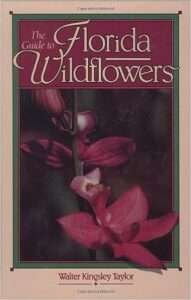
Purple Native Flowers Common to Central Florida

Amorpha fruiticosa
(Bastard False Indigo)

Latin Name: Amorpha fruiticosa
Common Names: Bastard False Indigo, Indigo Bush, False Indigo Bush, False Indigo, and Desert False Indigo.
Family: In the Fabaceae, or bean, family.
Form: It is a woody shrub that can grow to a height of fifteen feet.
Leaves: The leaves are alternate and odd pinnately compound. The leaflet’s margins are entire with short stalks. They are linear to elliptic in shape.
Flowers: The flowers are born in long racemes and appear in the spring and summer. The petals are a deep purple and the anthers are a bright yellow making for an unusual looking flower.
Habitat: It occurs naturally in riparian areas, and open wet forests.
Native Range: It is native to the following states: AL, AR, AZ, CA, CO, CT, DC, DE, FL, GA, IA, ID, IL, IN, KS, KY, LA, MA, MD, ME, MI, MN, MO, MS, NC, ND, NE, NH, NJ, NM, NY, OH, OK, OR, PA, RI, SC, SD, TN, TX, UT, VA, VT, WA, WI, WV, and WY.
Landscape Use: In the home landscape it can be grown in full sun to part shade with average to moist soils.
Wildlife Uses: The flowers attract many pollinators.
Propagation: It can be grown from seed or transplants.
Asclepias humistrata
(Sandhill Milkweed)
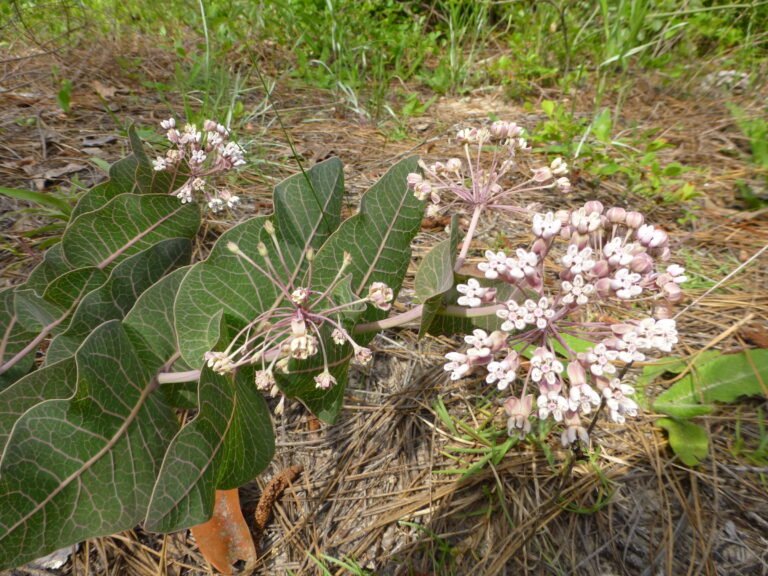
Latin Name: Asclepias humistrata
Common Names: Sandhill Milkweed and Pinewoods Milkweed.
Family: It is in the Apocynaceae, or dogbane, family.
Form: This wildflower grows to about two feet with some branches remaining upright while many lay prostrate along the ground.
Leaves: The leaves are opposite, clasping at the stem, and ovate in shape. They are a blueish green in color with pink veins.
Flowers: The flowers appear in the spring and summer.
Habitat: It occurs naturally in pinelands, sandhills, and scrub.
Native Range: It is native to the following states: AL, FL, GA, LA, MS, NC, and SC.
Landscape Use: In the home landscape it can be grown in full sun to part shade with average to dry soils.
Wildlife Uses: Beetles and wasps use the flowers as a nectar source and the foliage is used as a larval food for the monarch, soldier, and queen butterflies.
Propagation: It can be grown from seed. It is very difficult to transplant.
Cirsium horridulum
(Purple Thistle)
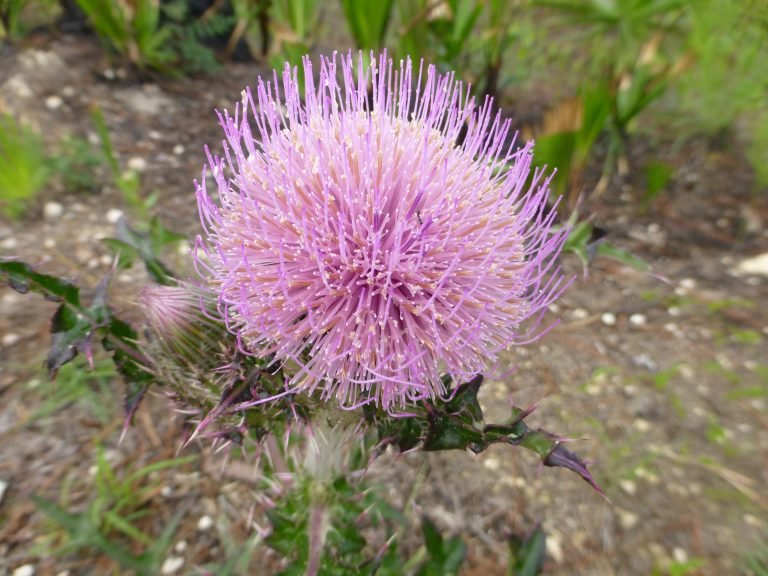
Latin Name: Cirsium horridulum
Common Names: Bristle Thistle, Yellow Thistle, Horrid Thistle, Spiny Thistle, and Bull Thistle.
Family: It is found in the Asteraceae, or aster, family.
Habit: A perennial wildflower that grows to a height of three feet when in bloom.
Leaves: The leaves are alternate, spiny and lobed. The leaf base clasps around the flower stalk.
Flowers: Flowers appear in the spring, summer and fall.
Habitat: Pinelands, roadsides, dry forests, pastures, and disturbed sites.
Landscape Use: It grows in full sun to part shade with average to dry soils.
Native Range: It is native to AL, AR, CT, DE, FL, GA, LA, MA, MD, ME, MS, NC, NH, NJ, NV, NY, OK, PA, RI, SC, TN, TX, and VA.
Wildlife Use: Purple thistle is a favorite nectar plant for butterflies and bees! The seeds are eaten by small songbirds such as sparrows and finches.
Propagation: It can be grown from seed and transplanted. When transplanting remove any flower stalks so the plant can use its resources to regrow roots.
Conradina grandiflora
(Largeflower False Rosemary)

Latin Name: Conradina grandiflora
Common Names: Largeflower False Rosemary.
Family: It is found in the Lamiaceae, or mint, family.
Form: A perennial wildflower that grows to a height of about 3 to 6 feet with the main stalks becoming woody with age.
Leaves: The leaves appear on stalks in whorls of 4 to 7. The margins are scalloped or toothed with pointed tips.
Flowers: The upper lip of the flower is a pale purple and the lower portion has three lobes with the center one spotted purple. The flowers appear all year.
Habitat: It naturally occurs in dry sites such as pinelands and scrub.
Native Range: It only occurs naturally in Florida.
Landscape Use: In the home landscape largeflower false rosemary can be planted in just about any dry, sunny, location. It works great interplanted with other native wildflowers.
Wildlife Uses: The flowers are a nectar source bees. The shape of the flower provides a perfect landing platform for bees to enter the flower while collecting pollen on their backs to help pollinate the next flower it visits.
Propagation: It transplants relatively well when small. Some native nurseries carry it in stock.
Elephantopus elatus
(Tall Elephant's Foot)
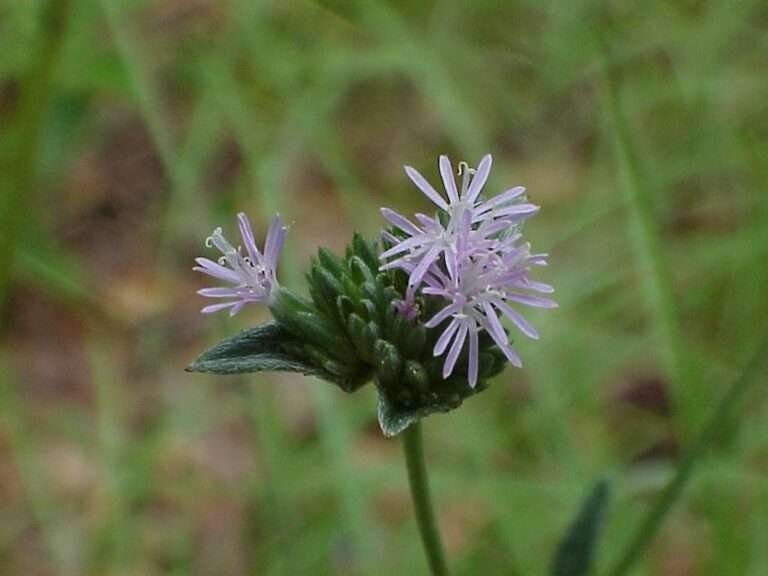
Latin Name: Elephantopus elatus
Common Names: Tall Elephants-foot and Florida Elephant’s-foot.
Family: It is found in the Asteraceae, or aster, family.
Form: It is a perennial wildflower that reaches a height of about two feet when in bloom. When not in bloom only a rosette of basal leaves are seen.
Leaves: Leaves are mainly basal and they are broad and hairy.
Flowers: The pale purple flowers sit atop three leaflike triangular bracts. This structure provides pollinators with a landing platform while nectaring. The small pale purple flowers appear in the summer and fall.
Habitat: It is found in dry sites such as deciduous forests, flatwoods and sandhills.
Native Range: It is native to the following states: AL, FL, GA, LA, MS, and SC.
Landscape Use: In the home landscape it grows in dry soils with sun to part shade.
Wildlife Uses: Small butterflies and bees use the flowers as a nectar source. The seeds are eaten by some songbirds.
Propagation: It can be grown from seed and transplants very well. When transplanting be sure to remove any upper growth or flowers to help the transplant recover more quickly.
Garberia heterophylla
(Garberia)
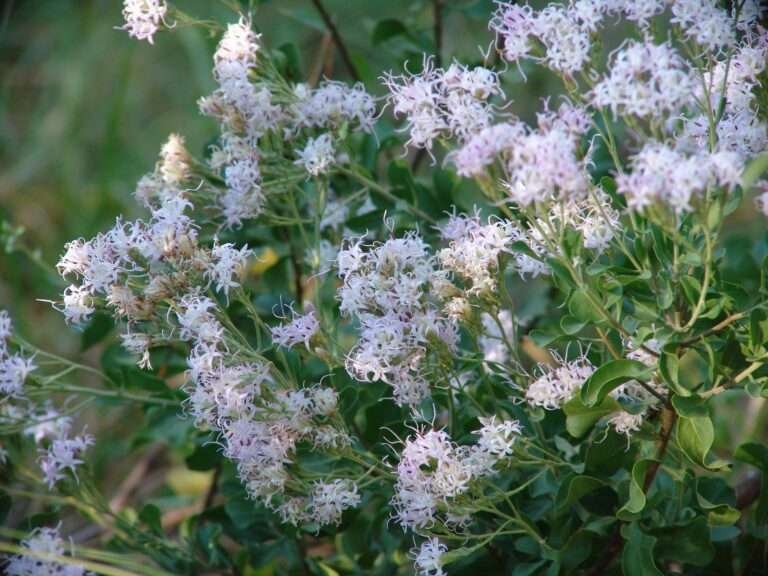
Latin Name: Garberia heterophylla
Common Names: Garberia
Family: It is found in the Asteraceae, or aster, family.
Form: It is a perennial wildflower that can grow to a height of six feet, but generally is around four feet. Its stems become woody with age and it takes on a shrub like appearance. They are generally found growing in groups or colonies as opposed to a single specimen.
Leaves: The leaves are alternate and stalked with entire margins. They are grayish-green in color.
Flowers: The flowers are pale purple and appear in the summer, fall, and early winter. The flowers are fragrant.
Habitat: It occurs naturally in dry pinelands and dry forests such as oak scrub.
Native Range: Native to Florida only (endemic).
Landscape Use: In the home landscape it should be planted in full sun or high shifting shade for best flowering.
Wildlife Uses: The flowers are used by many of Florida’s pollinators. The seeds are eaten by some songbirds. The colonies that garberia form in their natural environment provide shelter and feeding areas for many wildlife species.
Propagation: It can be propagated by seed and transplanting. When transplanting focus on small specimens and remove any upper growth so the plant can put its energy into recovering.
Justicia pringlei
(Cooley's Water Willow)
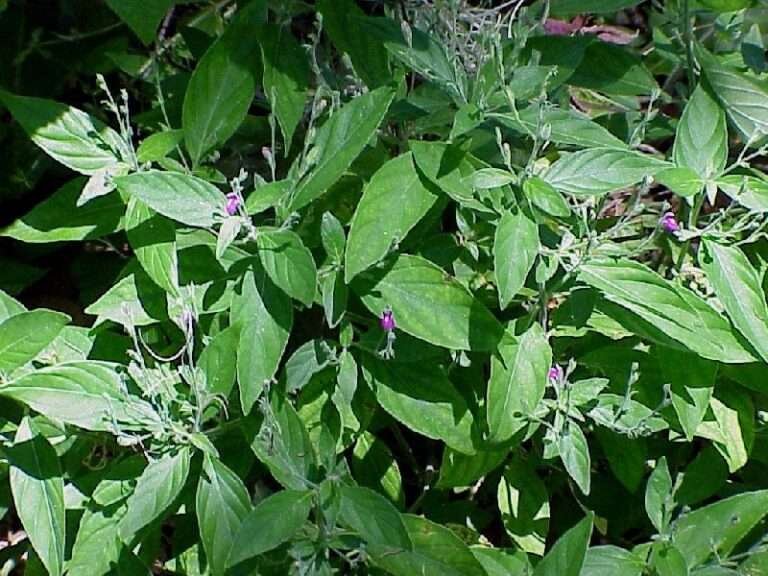
Latin Names: Justicia pringlei previously known as Justicia cooleyi.
[Okay I cheated on this one because it isn’t common, but it is a native (endangered) and has amazing purple flowers so I had to include it. I’m also hoping that it will get more recognition because it’s a great little wildflower for underneath oak trees!]
Common Names: Cooley’s Water Willow and Cooley’s Justicia.
Family: It is found in the Acanthaceae, acanthus, family.
Form: It is a perennial wildflower that grows to a height of about a foot.
Leaves: The leaves are opposite, lanceolate to ovate, hairy, with entire leaf margins and short stalks.
Flowers: The small bright magenta flowers appear in the late spring, summer and fall. The flowers are used as a nectar source by many small butterflies and bees.
Habitat: It is found growing naturally in the shade of rocky woods and oak hammocks. It can tolerate drought as well as moist soils, but does not grow in standing water.
Native Range: It is an endangered Florida wildflower and has only been documented growing in Hernando, Sumter, and Lake Counties.
Landscape Use: In the home landscape it makes a great groundcover underneath the heavy shade of large oak trees. The plants get to about a foot in height and require no maintenance whatsoever except for an occasional weeding. Cooley’s water-willow is drought tolerant and can rely on average rainfall helped with a layer of leaf litter to retain moisture and provide nutrients.
Wildlife Uses: The flowers are used as a nectar source by many small butterflies and bees.
Propagation: Propagation is achieved through transplanting and seeds.
Transplants should be trimmed of most foliage and all flowers so as not to stress the plant out when moving it to a new location. I trim the entire top of the plant off with a pair of scissors (to about 4 inches high), dig up the roots with a small trowel and move to the new location being sure to water it until it is established or plant during a rainy spell.
Liatris spicata
Dense Gayfeather

Latin Name: Liatris spicata
Common Names: Dense Blazing Star, Dense Gayfeather, Dense Liatris, Marsh Blazing Star, Marsh Gayfeather, and Marsh Liatris.
Family: It is found in the Asteraceae, or aster, family.
Form: Liatris is a perennial wildflower that grows to a height of about four to six feet when in flower.
Leaves: The leaves are alternate, linear with the lower leaves being the longest and widest.
Flowers: The flowers are brilliant purple spikey racemes that appear in the summer and fall.
Habitat: It occurs naturally in moist pinelands and forests.
Native Range: Liatris spicata is native to the following states: AL, AR, CT, DC, DE, FL, GA, IL, IN, KY, LA, MA, MD, MI, MO, MS, NC, NJ, NY, OH, PA, SC, TN, VA, WI, and WV.
Landscape Use: In the home landscape it can be planted in full sun to high shifting shade. It looks best planted en masse or mixed with other wildflowers with the same requirements such as goldenrod.
Wildlife Uses: The flowers are a nectar source for bees and butterflies.
Propagation: Propagation is generally achieved by seed, but it transplants very well because the root is a hardy bulb. Remove any upper foliage or flowers before transplanting so the plant can recover without too much shock.
Lycium carolinianum
(Christmas Berry)

Latin Name: Lycium carolinianum
Common Names: Christmas Berry, Carolina Wolfberry, Carolina Desert-thorn, Creeping Wolfberry, and Christmas Berry.
Family: It is in the Solanaceae, or the nightshade, family.
Form: Christmas berry is a tardily deciduous, and many times evergreen, shrub that rarely exceeds six feet in height. It is sparingly branched with many of the curving branches ending in a sharp thorn.
Leaves: The leaves are dull gray-green, thick, succulent, 1/2 inch long, narrowly ovate, and smooth with entire margins.
Flowers: The flowers are pale lavender in color and are born in the leaf axils. The corolla of the small flower may be lavender to nearly white with the throat streaked with purple. The blooms appear in March through December.
Habitat: Christmas berry is very salt tolerant and is found growing in salt water all along the coast of Florida. In rocky areas along the shore it can be found growing in between rock crevices at the water’s edge.
Native Range: Christmas berry is native to the following states: AL, FL, GA, LA, MS, SC, and TX.
Landscape Use: Christmas berry grows in full sun, with average moisture, and an average pH.
Wildlife Uses:
Propagation: It can be grown from seed, cuttings, or transplants.
Passiflora incarnata
(Purple Passionflower)
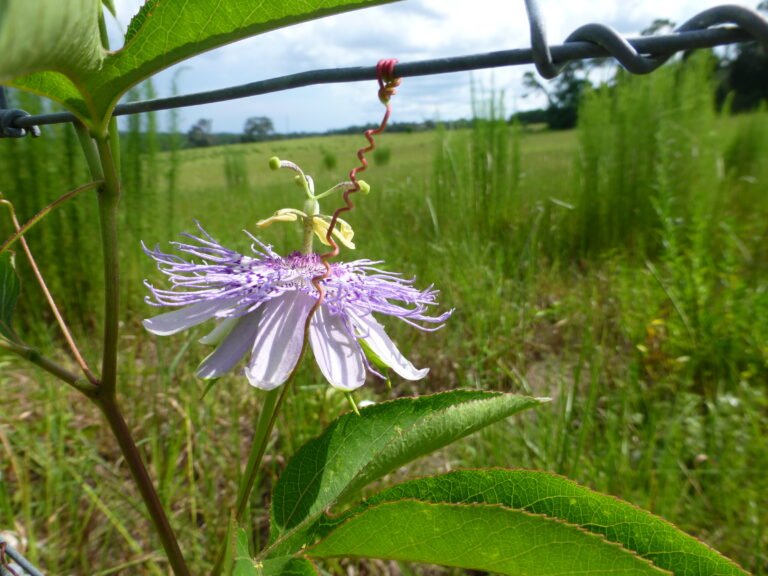
Latin Name: Passiflora incarnata
Common Names: Purple Passionflower, Maypop, Purple Passion Vine and Apricot Vine.
Family: It is in the Passifloraceae, or passion-flower, family.
Form: Passiflora incarnata is a perennial vine climbing by tendrils, but generally growing prostrate. It spreads by underground stems (rhizomes) and can be found coming up quite far away from its original planting.
Leaves: The leaves are finely toothed, deeply (three – five) lobed, 2 1/2″ wide – 6″ long, with glandular petioles.
Flowers: The flower sepals are white, and the petals bluish-white, with a lavender, fringed corona of blue-purple, banded with purple. They are approximately 4″ inches in diameter and appear in the spring, summer & fall.
Habitat: It is found in the full sun of open woods & old fields. Found throughout the state.
Native Range: AL, AR, DC, DE, FL, GA, IL, IN, KS, KY, LA, MD, MO, MS, NC, OH, OK, PA, SC, TN, TX, VA, and WV.
Landscape Use: In the home landscape it grows in full sun with average moisture. It has a tendency to move around and will pop up in another flower bed besides the one it was planted in. It spreads by underground rhizomes and if planted in too shady of an area will actually move itself into the sun. Most gardeners find it annoying that it won’t stay put where they planted it so keep that in mind when growing this beauty.
Wildlife Uses: In Central Florida it is a larval food for the zebra longwing and gulf fritillary butterflies. Gulf fritillaries prefer this species over the others because they like more sunshine as does the purple passion vine.
Propagation: Grown from seed, transplanting, and root cuttings.
Piloblephis rigida
(Wild Pennyroyal)
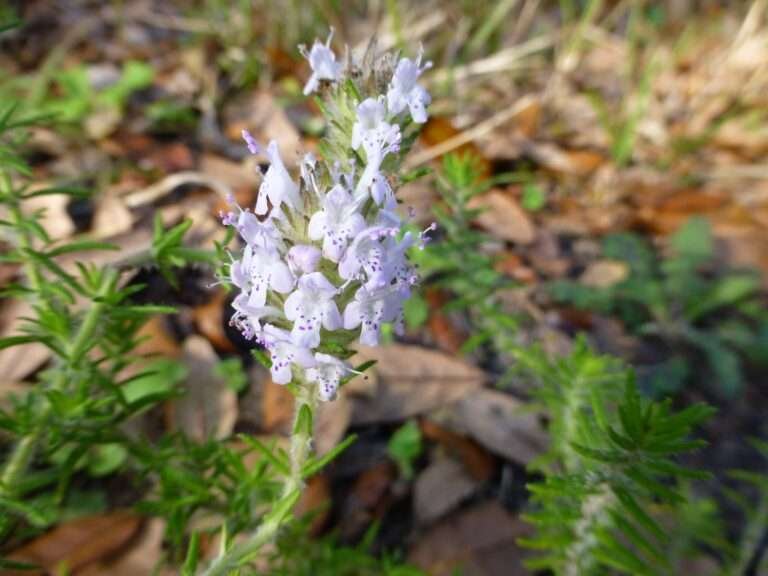
Latin Name: Piloblephis rigida
Common Names: Wild Pennyroyal and Florida Pennyroyal.
Family: It is found in the Lamiaceae, or mint, family.
Form: A perennial, evergreen, wildflower that develops woody stems and resembles the culinary herb rosemary. It grows to a height of two feet.
Leaves: The leaves are opposite, thick, linear and needlelike. The leaves are fragrant and can be used to make a tea.
Flowers: The flowers are formed on dense heads with two upper lips and three lower lips. Blooms appear all year.
Habitat: It occurs naturally in pinelands, sandhills, and open forests.
Native Range: This species is nearly endemic to Florida, found otherwise in extreme southeastern Georgia.
Landscape Use: In the home landscape it is best planted in full sun. It can survive on rainfall once established, however it blooms best with a little TLC especially in the summer when droughts hit.
Wildlife Uses: The bees love the flowers and some of the smaller butterflies used it as a nectar source as well.
Propagation: Achieved through seed, cuttings and transplants.
Pontederia cordata
(Pickerelweed)

Latin Name: Pontederia cordata
Common Names: Pickerelweed and Pickerel Rush.
Family: It is in the Pontederiaceae, or pickerel-weed, family.
Form: It attains a height of approximately three feet above the water, or mud. They become dormant in the winter.
Leaves: Its leaves grow on long, fleshy stalks, are arrowhead shaped, and are three to seven inches in length.
Flowers: Its blooms, which grow on conspicuous spikes, appear in late spring and continue blooming until early fall. The flower spikes grow on fleshy stems, and are six inches in length, purple-blue, and rarely white.
Habitat: It occurs naturally in streams, marshes, wet ditches, ponds, lake margins and other riparian areas.
Native Range: It is native to AL, AR, CT, DC, DE, FL, GA, IA, IL, IN, KS, KY, LA, MA, MD, ME, MI, MN, MO, MS, NC, NH, NJ, NY, OH, OK, OR, PA, RI, SC, TN, TX, VA, VT, WI, and WV.
Landscape Use: It is an aquatic plant so in the home landscape it would be grown in a pond or other large container which holds water. Place in a sunny location for best blooming.
Wildlife Uses: The blooms provide nectar for a number of insects including bees, wasps, and butterflies. The red, sticky fruit is considered an important wildlife food and is eaten by ducks and other animals.
Propagation: It is easy to propagate through root division, and may be divided during the blooming season. Some native plant nurseries, and pond supply stores, in our area carry pickerelweed. It is actually much easier to locate a pond and put on your wellies and get a few to transplant.
Ruellia caroliniensis
(Carolina Wild Petunia)
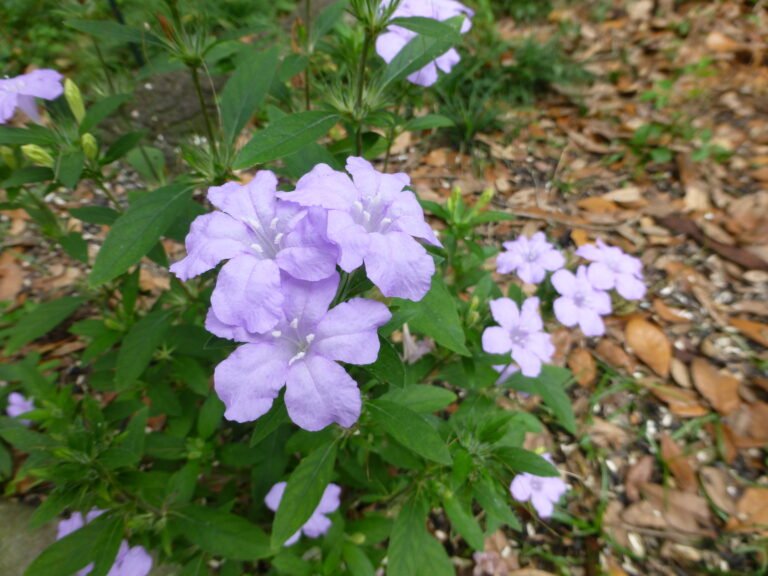
Latin Name: Ruellia caroliniensis
Common Name: Carolina Wild Petunia and Wild Petunia.
Family: It is found in the Acanthaceae, acanthus, family.
Form: It is a perennial wildflower that grows to a height of about two feet although some literature says it grows much higher I have not found that to be the case.
Leaves: Opposite, ovate to elliptic in shape, stalked, with entire margins.
Flowers: The pale lavender, large petaled, blooms appear in the spring, summer and fall and are a favorite of butterflies and bees.
Habitat: Dry, open, forests, sandhills, flatwoods, and clearings.
Native Range: AL, AR, DC, DE, FL, GA, IL, IN, KY, LA, MD, MS, NC, NJ, OH, OK, PA, SC, TN, TX, VA, and WV.
Landscape Use: It grows in full sun to part shade with average moisture. It grows in poor soils where little else will grow and it also does great as a container flower.
Wildlife Uses: Bumblebees and butterflies use the flowers as a nectar source.
Propagation: They transplant well and can also be grown from seed.
Symphyotrichum elliottii
(Elliot's Aster)

Latin Name: Symphyotrichum elliottii. Previously known as Aster elliottii.
Common Name: Elliott’s Aster and Marsh American-aster.
Family: It is found in the Asteraceae, or aster, family.
Form: A perennial wildflower that grows to a height of 3 feet and spreads by underground runners.
Leaves: Alternate, oblanceolate with toothed margins.
Flowers: Beautiful purple flowers that appear in late summer, fall, and winter.
Habitat: It occurs naturally on pond margins, wet ditches, wetlands and low areas with constant moisture.
Native Range: Elliott’s aster is native to AL, FL, GA, LA, MS, NC, and SC.
Landscape Use: Grows in part shade to full sun with moist to wet soils. A trick I use is to plant it in an area of the lawn that has constant moisture and just mow around it for maintenance.
Wildlife Uses: Bees and butterflies use the flowers as a nectar source.
Propagation: It can be grown from seed or transplants. It transplants very well as long as you remove upper flowers and most of the foliage so it can recover from the shock well enough to survive the transplanting.
Vernonia gigantea
(Giant Ironweed)
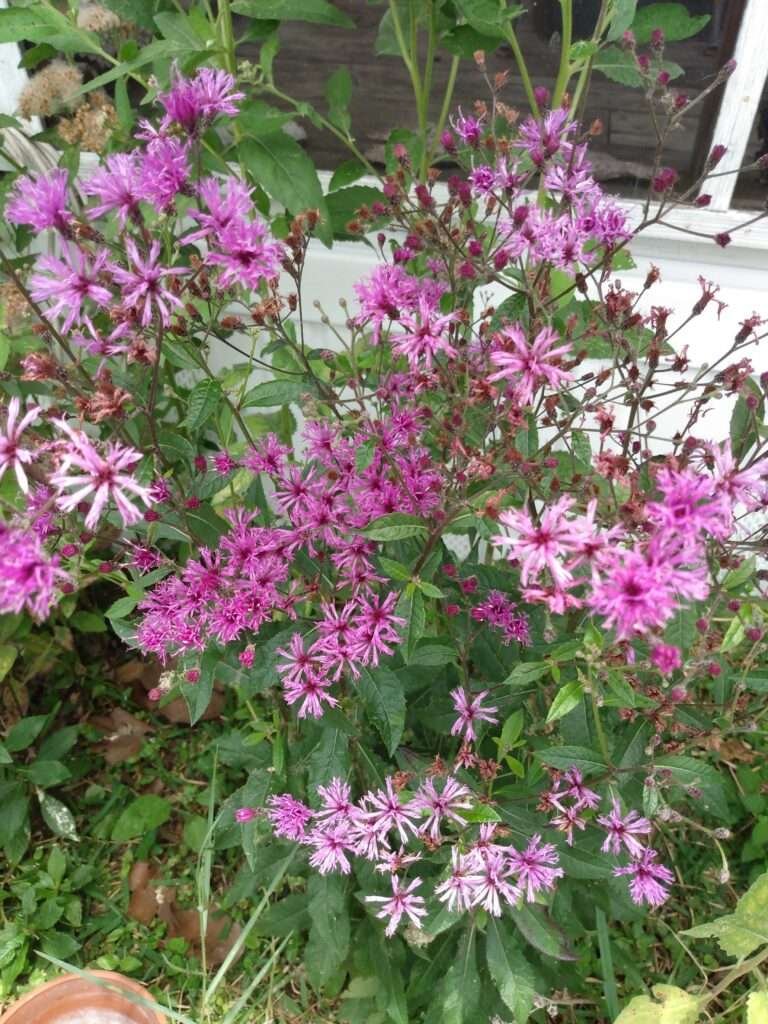
Latin Name: Vernonia gigantea
Common Names: Giant Ironweed and Tall Ironweed.
Family: It is found in the Asteraceae, or aster, family.
Form: Giant ironweed is a perennial wildflower that grows to a height of up to six feet.
Leaves: The leaves are alternate with entire to slightly toothed margins. They are elliptic to lanceolate in shape. Leaves are much reduced the higher up the stalk you go.
Flowers: The bright purple flowers form in heads with tubular petals. They appear in late spring, summer and fall.
Habitat: It occurs naturally in wet pinelands and forests.
Native Range: AL, AR, DE, FL, GA, IA, IL, IN, KS, KY, LA, MD, MI, MO, MS, NC, NY, OH, OK, PA, SC, TN, TX, VA, and WV.
Landscape Use: In the home landscape ironweed should be planted in full sun for best flowering. It can tolerate a wide range of moisture from dry to moist, but cannot live in standing water.
Wildlife Uses: Butterflies, bees, and many other pollinators use the flowers as a nectar source.
Propagation: It can be grown from seed and transplanted. When transplanting be sure to remove most of the upper foliage and flowers to help the plant recover from the shock.
Viola sororia
(Common Blue Violet)

Latin Name: Viola sororia
Common Names: Common Blue Violet, Florida Violet, Meadow Violet, Confederate Violet, Dooryard Violet, Purple Violet, and Wood Violet.
Family: It is found in Violaceae, or violet, family.
Form: A perennial wildflower that grows to a height of 6 to 8 inches.
Leaves: The leaves are basal with shallowly toothed margins. They are triangular to ovate in shape and stalked.
Flowers: The purplish-blue flowers appear in the winter and spring. The best flowering times are during the cooler months.
Habitat: Common violets are found occurring naturally in moist areas such as the open areas of riparian forests, roadsides, and wet areas along roadways.
Native Range: AL, AR, CT, DC, DE, FL, GA, IA, IL, IN, KS, KY, LA, MA, MD, ME, MI, MN, MO, MS, NC, ND, NE, NH, NJ, NY, OH, OK, PA, RI, SC, SD, TN, TX, VA, VT, WI, and WV.
Landscape Use: In the home landscape they can be grown in just about any part shade area that stays relatively moist. They are also a great addition to a container garden because during the hotter months you don’t really see them, but once it gets cooler they begin to flush with new foliage and then put out blooms. Also they don’t take up much space so can be easily tucked in between other plants.
Wildlife Uses: The flowers are used as a nectar source by bees, the seeds are eaten by songbirds, and the foliage is browsed by deer. The foliage, and flowers, are edible and can be added to salads or food items as decoration.
Propagation: They can be grown easily from seed and transplant very well. If you purchase plants online be sure to find a grower close to your area because if you purchase them from northern US nurseries they do not have the ability to acclimate to our Florida climate and won’t survive.

Nurseries that sell Florida Native Plants in Central Florida

The Nectary
A native plant nursery that is open to the general public.
Thursday 11am-3pm
Fridays and Saturdays 9 am – 3 pm
They are located in Lakeland, Florida
1047 E. Main Street, Lakeland, FL.
(863) 937-7879
Use this link to get to Google Maps to show the location.
1047 E. Main St, Lakeland FL 33801

The Natives
A native plant nursery that is open to the general public.
Thursdays from 9 – 12.
They are located in Davenport, Florida.
2929 J. B. Carter Road, Davenport, FL.
863-422-6664
Use this link to get to Google Maps to show the location.
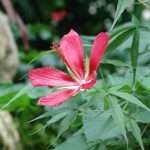
Mail Order Natives
We have provided native plants to wonderful people across the USA for 15 years. That is our mission! We also would like you to know our plants are NEVER collected from the wild. We grow all of our plants from seed or cuttings in our own facility. We will be adding extra plant selections over the next few months, so come back regularly. You can contact us at: 850-973-7371 (cell), 850-971-5416 (fax), and email: mailordernatives@gmail.com
A native plant nursery that ships plants through the mail.
They are located in Lee, Florida.
Their plants are the most gorgeous natives that I have ever purchased. Yes shipping can be expensive, but it is so worth it because of the quality of the plants. They also pack their orders with great care. I’ve been thrilled with every purchase and I’m sure you will be too.

Green Isle Gardens
Green Isle Gardens specializes in Florida native plants and wildflowers, with a focus on upland plant species. The nursery has 8 acres under production and features more than 150 species of native plants.
Our plants are grown without using pesticides with the goal of preserving nature, and all its critters, in mind. We encourage the use of pine straw mulch and offer bales for sale.
Green Isle Gardens is open to the public for retail sales.
Wednesday – Friday: 8am to 3:30pm
Saturday: 8am to 3pm
They are located in Groveland.
Green Isle Gardens Retail Plant List
Green Isle Gardens
11303 Florida 33
Groveland, FL 34736
Use this link to go to Google Maps to show the location:
